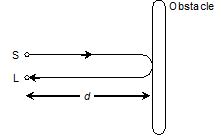
EFFECT OF TEMPERATURE ON THE SPEED OF SOUND
Sound of Class 9
Sound travels faster as the temperature of the medium increases and vice-versa. This happens because as temperate increases, the particles of the medium collide more frequently and hence the disturbance spreads faster.
Speed of sound in air increases by 0.61 m/s with every 1 o C increases in temperature. For example if speed of sound in air at 0 o C is 330 m/s, then its speed at 25 o C will be 345 m/s.
Speed of sound does not depend on the pressure of the medium if temperature of the medium remains constant.
ECHO:
An echo is defined as the phenomenon of repetition of sound of a source by reflection from an obstacle.
It is a very common experience that when we utter a few words in a high domed hall the words are repeatedly heard on account of reflection from the original sound, the obstacle must be situated at a suitable distance.
|
The sensation of sound lasts in our brain for (1/10) of a second. This property is called persistence of hearing. Thus, the time interval between the original sound and the reflected one must be at least 0.1s. The total distance covered by the sound from the point of generation to the reflecting surface and back should be at least 344 m/s × 0.1s = 34.4 m. Thus, for hearing distinct echoes, the minimum distance of the obstacle from the source of sound must be half of this distance that is 17.2 m. This distance will change with the temperature of air. |
|
It is of three types:
(a) Instantaneous echo (b) Syllabic echo (c) Successive echo
INSTANTANEOUS ECHO:
The echo of sound of short duration (like clap, pistol shot) is called instantaneous echo. It is found that sensation of any sound persists for
 to
to
 seconds in our ear, after it, the existing sound dies off. This time is called persistence of sound or persistence of hearing. It varies from persons to person and also with frequency of sound. We will use
seconds in our ear, after it, the existing sound dies off. This time is called persistence of sound or persistence of hearing. It varies from persons to person and also with frequency of sound. We will use
 second as a typical interval needed to distinguish two sounds.
second as a typical interval needed to distinguish two sounds.
SYLLABIC ECHO:
The echo of syllables of spoken words is called syllabic echo.
This echo is clear when the sound of last syllable of speech is reflected from an obstacle at least 22 m away so that sound takes atleast
 second during which the last syllable is compactly spoken.
second during which the last syllable is compactly spoken.
SUCCESSIVE ECHO:
This echo is head when sound is produced between two distant parallel rows of tall buildings or hills. A number of echoes are heard successively due to the multiple reflection. This echo is heard only in vast open field.








